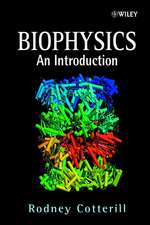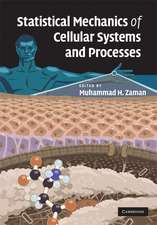Mechanisms and Phylogeny of Mineralization in Biological Systems: Biomineralization ’90
Editat de Shoichi Suga, Hiroshi Nakaharaen Limba Engleză Paperback – 13 dec 2011
Preț: 655.60 lei
Preț vechi: 771.30 lei
-15% Nou
Puncte Express: 983
Preț estimativ în valută:
125.45€ • 131.33$ • 103.80£
125.45€ • 131.33$ • 103.80£
Carte tipărită la comandă
Livrare economică 07-21 aprilie
Preluare comenzi: 021 569.72.76
Specificații
ISBN-13: 9784431681342
ISBN-10: 4431681345
Pagini: 532
Ilustrații: XIV, 517 p.
Dimensiuni: 170 x 244 x 28 mm
Greutate: 0.84 kg
Ediția:Softcover reprint of the original 1st ed. 1991
Editura: Springer
Colecția Springer
Locul publicării:Tokyo, Japan
ISBN-10: 4431681345
Pagini: 532
Ilustrații: XIV, 517 p.
Dimensiuni: 170 x 244 x 28 mm
Greutate: 0.84 kg
Ediția:Softcover reprint of the original 1st ed. 1991
Editura: Springer
Colecția Springer
Locul publicării:Tokyo, Japan
Public țintă
ResearchDescriere
Various kinds of mineralization have been found in many biological systems. Investigations made at a microscopical level using various sophisticated analytical methods and using principles developed in different fields have clarified their mechanisms very much. Sometimes, very similar phenomena have been found in the mineralized tissues of completely different biological systems. Compilation and comparative investigations of such findings obtained from the many specimens systematically collected contribute a great deal to an understanding of the crucial mechanisms and significance of biominerali zation which originated in very primitive organisms and remain in advanced ones. Previously, the functional significance of mineralized tissues was considered mainly from an anatomical point of view based upon their morphological and structural features. However, the recent advance of investigations has made it possible to interpret the func tional significance of biomineralization not only from local and mechanical points of view, but also from a systemic and phylogenetic point of view. It is also well-known that biomineralization has contributed in various ways to geological and oceanographical conditions of the environment in which the organisms were living. During this process, the mechanisms of biomineralization may have evolved to maintain harmony between organisms and their environments.
Cuprins
1 Organic Matr.- 1.1 S-Layer Similarity in Matrix and Mineral Structure of a Leptotrix Species (Bacteria).- 1.2 The Organic Matrix of Spicules of the Gorgonian Leptogorgia virgulata.- 1.3 Mineral-Associated Proteins from Modern Planktonic Foraminifera.- 1.4 Structure and Function of the Organic Matrix in the Nacreous Layer of Pinctada fucata.- 1.5 Intracrystalline Proteins from a Sea Urchin and a Mollusk: A Comparison.- 1.6 Intracrystalline Molecules from Brachiopod Shells.- 1.7 Morphological Evidence of Coherent Organic Material within the Stereom of Postmetamorphic Echinoderms.- 1.8 Molecular Recognition in Biomineralization.- 1.9 Otolith Matrix Proteins of Walleye Pollock; Biochemical Properties and Immunohistochemical Localization in the Saccular Tissue.- 1.10 The Water-Soluble Organic Matrix in the Egg Shells of the Extinct Moa and the Extant Rhea.- 1.11 Morphological Manifestations in Hypocalcemic Conditions — Their Relation to Molecular Structural Changes of Glycosaminoglycans in Basement Membrane and Matrix.- 1.12 Enamelin and Enameloid.- 1.13 Amelogenin Degradation by an Enzyme Having Acidic pH optimum and the Presence of Acidic Zones in Developing Bovine Enamel.- 1.14 On the Physical Role of Amelogenin in the Biomineralisation of Tooth Enamel.- 1.15 Noncollagenous Proteins of Sea Bream Dentine.- 1.16 Immunoblotting Study of Developing Enamel Matrix Proteins.- 1.17 Mineral Induction by Immobilized Polyanions.- 1.18 Interactions of Bovine Dentin Phosphophoryn with Calcium Phosphates.- 1.19 Immunohistochemical and Enzyme Histochemical Studies in Bone Formation Induced by Bone Morphogenetic Protein (BMP) in Mouse Muscle Tissue.- 1.20 Analysis of the Organic Matrix Associated with Calcium Oxalate Crystals in Vitis mustangensis.- 2 Mineralization.- 2.1 From Calcium in Molluscs to Coral Grafted into Bone: an Example of Basic to Applied Research Transfer.- 2.2 Fine Structure of Skeletal Growth-Ridge in some Scleractinian Corals.- 2.3 Fusiform and Needle-shaped Crystals Found on the Skeleton of a Coral, Galaxea fascicularis.- 2.4 Fine Structure of the Regenerating Sites of the Stalk in a Solitary Coral Fungia fungites after Decalcification of the Skeleton.- 2.5 Larval Shell Formation and Mineralogy in Neptunea arthritica (Bernardi) (Neogastropoda: Buccinidae).- 2.6 Using Plasma-Etching and Proteolytic Enzymes in Studies of Molluscan Shell Ultrastructure.- 2.7 Hormonal Control of Confirmed Shell Growth in the Snail Helisoma duryi (Mollusca: Gastropoda).- 2.8 Epizootic Disease in the “Black lip” Pearl Oyster Pinctada margaritifera in French Polynesia: Ultrastructural Alterations of the Nacreous Layer.- 2.9 Inorganic Composition of Cystoliths Isolated from Leaves of Higher Plants.- 2.10 Formation and Solubility of Carbonated Tooth Minerals.- 2.11 Effects of Calcium and Phosphate Deficiencies on Bone Metabolism in a Teleost, Tilapia (Oreochromis niloticus): A Histomorphometric Study.- 2.12 Nanospace Theory For Biomineralization.- 2.13 The Initial Mineralization During Tooth Development in Sharks.- 2.14 Effects of 1-Hydroxyethylidene-1, 1-Bisphosphonate (HEBP) on the Maturation Enamel in Rat Incisor.- 2.15 Ultrastructure of Rat Ameloblasts During Enamel Maturation Observed by Scanning Electron Microscopy.- 2.16 Changes of the Ratio of Calcium and Phosphate in Mineralizing Tissues.- 2.17 Two Patterns of Calcification in Rat and Rabbit Incisor Dentin.- 2.18 Spontaneous Mineral Aggregations in the Circumpulpal Dentine Formation.- 2.19 The Role of the Organic Matrix in Dentine (Re)mineralization.- 2.20 Pathologic Mineralization in Humans.- 2.21 Organization of Crystals in Bone.- 2.22 Histological Studies on the Otolith of Huso huso, Chondrostei.- 2.23 Effect of Physiology and Endolymph Composition on the Strontium Content of Bearded Rock Cod (Pseudophycis barbatus) Otoliths.- 2.24 Modelling Biomineralization: Studies on the Morphology of Synthetic Calcite.- 2.25 Physical Chemical Studies of Mineralization and Demineralization of Apatites.- 3 Trace Elements.- 3.1 Controlled Deposition and Transformation of Iron Biominerals in Chiton Radula Teeth.- 3.2 Mineralization of Iron in Ferritin and Haemosiderin: The Effect of Tissue Environment on Mineral Structure.- 3.3 Studies on the Transport Mechanism of Iron in Rat Incisor Enamel.- 3.4 Elemental Distribution on the Growth Front of Oyster Shell Measured by Synchrotron Monochromatized X-rays.- 3.5 Crystallographic Behavior of Iron and Magnesium in Hydroxyapatite Crystals.- 3.6 Magnesium in Normal and Pathological Calcifications.- 3.7 Manganese Accumulation in Freshwater Bivalves.- 3.8 Scanning and Transmission Electron Microscopy, X-ray Microanalysis and Electron Diffraction of Pineal Concretions in Aging Rats.- 4 Evolution.- 4.1 On the Initiation of the Hard Tissues of Animals During the Late Precambrian to the Early Cambrian.- 4.2 Nacre Formation in Bivalve and Gastropod Molluscs.- 4.3 Bacterial Mineralization in Cherts.- 4.4 Biological Accumulation of Different Chemical Elements by Microorganisms from Yellowstone National Park, USA.- 4.5 Genetic Characterization of a Magnetic Bacterium Aquaspirillum sp.- 4.6 Coccolith Accumulation Rates: Cretaceous to Recent.- 4.7 Amorphous Minerals and Theories of Biomineralization.- 4.8 Evolution of Enamel Proteins: a Paradigm for Mechanisms of Biomineralization.- 4.9 Correlation Between the Size of Crystals and the Molecular Weight of Organic Fractions in the Soluble Matrices of Mollusc, Coral and Sponge Carbonate Skeletons.- 4.10 Exoskeletal Adaptations for Life Environment in Neritacean Gastropods.- 4.11 Microstructural Organization of the Exoskeleton of Some Articulate Brachiopods (Terebratulida, Rhynchonellida) — The Importance of the Calcitic Granules and the Effects of Diagenesis.- 4.12 Amorphous and Crystalline Phases in Biominerals.- 4.13 Evolutionary Trends of Shell Microstructure in Bivalve Molluscs.- 4.14 Coexistence of Different Shell Microstructure Types in a Single Shell Layer of the Veneridae (Bivalvia, Mollusca).- 4.15 Phosphate Gill Supports in Living and Fossil Bivalves.- 4.16 Orientation of Apatite and the Organic Matrix in Lingula Shells.- 4.17 Evolution of Fluoride and Iron Concentrations in the Enameloid of Fish Teeth.- 4.18 Evolutionary Trends of the Tooth Structure in Chondrichthyes.- 4.19 Ultrastructure of Pleromin, a Highly Mineralized Tissue Comprizing Crystalline Calcium Phosphate Known as Whitlockite, in Holocephalian Tooth Plates.- 4.20 Dental Apatites in Vertebrate Species: Morphology and Chemical Properties.- 4.21 Tooth Matrix Formation and Mineralization in Extant Fishes.- 4.22 Some Evolutional Tendencies of Mammalian Tooth Structure.- 4.23 Proboscidea Fossil Teeth Suggest the Evolution of Enamel Crystals.- 4.24 Development of Enamel Layar observed in Some Fossil Proboscideans.- 4.25 Well-Preserved Collagen from a Late Pleistocene Elephant Ivory.- 4.26 Comparative Biochemistry of Bone Matrix Proteins in Bovine and Fish.- 4.27 Effect of Phosphorous-Containing Compounds on Polymorphic Formation of Calcium Carbonate.- List of Participants.














